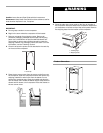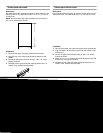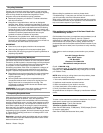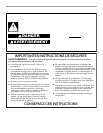
12
4. Vacuum the inside of the cabinet. Liquid spills or wet trash
should be cleaned up by hand, or by using a vacuum
designed to pick up liquids.
5. Wash the inside of the cabinet with a clean sponge or soft
cloth and a mild detergent in warm water. Rinse and dry
thoroughly with a soft cloth.
6. To replace the drawer, grasp it by the sides and insert the
rollers onto the tracks.
7. Lift the front of the drawer and push it in fully past the stops.
Cleaning the Ram
NOTE: You may want to wear protective gloves as there may be
bits of glass on the ram cover.
1. Wipe glass particles off of the ram cover with a cloth or paper
towels.
2. Remove foods with a clean sponge or soft cloth and a mild
detergent in warm water. Rinse and dry thoroughly with a soft
cloth.
Cleaning Before a Vacation
If you will be away for more than a couple of days, remove the
compactor bag. Remove the Key-Knob (or Key-Switch) and store
it out of children’s reach.
TROUBLESHOOTING
Try the solutions suggested here first in order to avoid the
cost of an unnecessary service call.
Trash is not compacting
■
Is the drawer less than half full? Drawer must be more than
half full before trash is compacted.
Your compactor won’t operate
■
Is the power supply cord unplugged? Plug into a grounded
3 prong outlet.
■
Has a household fuse or circuit breaker tripped? Replace
the fuse or reset the circuit breaker.
■
Is the drawer completely closed? Close the drawer firmly
and start the compactor again.
■ Is the Key-Knob turned all the way to START? Turn th e
Key-Knob (Key-Switch) fully to START and release (on some
models). See the “Starting the Compactor” section.
■
Did you press ON before pressing START? Press ON
before pressing START (on some models). See the “Starting
the Compactor” section.
The drawer won’t open
■ Is the ram all the way up? Drawer will open only when ram is
fully raised.
■
To raise the ram on models with a Key-Knob (or Key-
Switch): Turn the Key-Knob (Key-Switch) to START and
release. See the “Starting the Compactor” section.
■ To raise the ram on models with push button controls:
Press OFF, and then press ON. See the “Starting the
Compactor” section.
There is not enough compaction or force
■
Do you use the compacting cycle frequently enough?
Compacting works best when only a few items are loaded.
Bottles don’t break
■
How often do you notice this? Bottles will not break every
time. The thickness of the bottle’s glass and the content of
the trash load below it may prevent the bottle from breaking.
RECYCLING WITH YOUR
COMPACTOR
These codes indicate which type of plastic was used
in manufacturing the container. Your recycling
program will confirm which codes are accepted for
recycling.
Plastics with this symbol cannot be recycled.
Items with this symbol can be recycled or were made
from recycled materials.
A compactor makes recycling and landfill reduction efforts more
effective and efficient.
1
PETE
2
HDPE
3
V
4
LDPE
5
PP
6
PS
7
OTHER


















